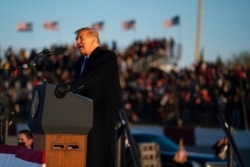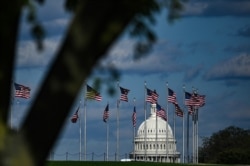One week before the November 3 election, Democratic presidential nominee Joe Biden is making a push into Republican-leaning states, while President Donald Trump plays defense, focusing on states he won in 2016 but where polls now show him trailing.
On Tuesday, Biden made two campaign stops in Georgia, a state not carried by a Democratic presidential contender since 1992. He plans to visit Iowa, Florida, Wisconsin and Michigan later this week. Trump won those states in 2016, but Democrats believe Biden has a chance to claim them in 2020.
Analysts say Biden's foray into so-called "red" states like Georgia and Iowa is a sign of confidence that his campaign is expanding the electoral map. If he can carry so-called "blue" states, swing states and a few Republican strongholds, his victory in the Electoral College would be larger, potentially giving him a greater mandate to govern.
"In politics, you always want to be on offense," said Matthew Continetti, a fellow at the American Enterprise Institute. "And in a changing South, where increases in population density and a suburban revolt against President Trump's personality benefit Democrats, Joe Biden has a chance."
From his campaign stop in Pennsylvania on Monday, Biden said he would win Michigan, Wisconsin and Minnesota. The former vice president also said he thought he had a "fighting chance" in Ohio, North Carolina, Georgia and Iowa where polls show tight races.
"I am not overconfident about anything," Biden said. "I just want to make sure we can earn every vote possible."
Some analysts question Biden's strategy.
"This is reminiscent of (2016 Democratic nominee) Hillary Clinton's dashing to Georgia and Arizona in the 2016 campaign's last days, when she should have been in Wisconsin and Michigan," said Larry Sabato, director of the Center for Politics at the University of Virginia. "We'll see next week."
Biden leads in polls
According to the latest average polls data, Biden leads Trump nationally by more than 7%.
Biden maintains his lead in key battleground or swing states, by razor-thin margins in the critical swing states of Pennsylvania and North Carolina.
The winner of the U.S. presidential election is not decided by the national popular vote but by Electoral College votes divided among the states according to population. It is a "winner-takes-all" system in all 50 states except Maine and Nebraska, where electoral votes are further divided up between the statewide popular vote winner and the winner in the states' congressional districts. A candidate needs 270 out of 538 electoral votes to win the presidency.
"President Trump needs some combination of the race tightening and a systematic polling error to come within striking distance of an Electoral College win," said Robert Griffin, director of research at the Democracy Fund Voter Study Group. "While that's possible, time is running out for a comeback."
Trump strategy
Trump is scouring swing states at a hectic pace, with stops in two, sometimes three, states daily in the final days before the election.
"His strategy is to replicate, as best he can, his upset victory four years ago," said Continetti. "His best chance at 270 is holding the Sunbelt and winning either Michigan or Pennsylvania."
Pennsylvania may be the most critical state for Trump to capture 270 electoral votes.
"There is a path for him if he loses Wisconsin or Michigan if he wins Pennsylvania," said Amanda Iovino, a Republican strategist at WPA Intelligence. "Biden's travel to the state, as well, shows that his campaign does not see Pennsylvania as a lock for the Democrats."
The Trump campaign is also focused on attracting minority voters in critical swing states. Nevada being on the president's travel schedule this week is likely reflective of improving numbers with Hispanic voters, particularly Hispanic men, said Iovino.
According to data from the Federal Election Committee, Trump is lagging Biden in campaign funds and spending his remaining cash on hand at record speed.
"Trump's money is gone or going fast, so he's depending on his personal rallies with Air Force One in the background to generate free media and enthusiasm in the key swing states," Sabato said.
Trump's closing argument to voter centers on the need to keep U.S. economic activity going, despite the pandemic. At recent rallies, he has repeatedly claimed America is "rounding the turn" on COVID-19, despite a recent surge in cases reported by Johns Hopkins University as Election Day nears.
"Voters are judging me on a lot of things," Trump said to reporters Tuesday as he left the White House. "And one of the things we've done a really good job on is COVID."
What Trump is describing is a different reality than what Americans are experiencing, said Jennifer Mercieca, who teaches presidential rhetoric at Texas A&M University.
"Americans are worried, and Trump downplaying the virus and its impact on their lives rings false," Mercieca said. "I don't think that will help him on Election Day."
On the campaign trail, Biden and his surrogates have slammed the president's handling of the pandemic, pointing to America's death toll of more than 225,000 from the coronavirus.
Senate races
Republicans are also concerned over the prospect of defeat in Senate races. This year, there are 35 Senate seats up for election — including a special election in Arizona.
The 100-seat Senate is currently led by 53 Republicans. To take control, Democrats need a net gain of three Senate seats — four if they lose the presidential election, since the vice president is also president of the Senate and has the tie-breaking vote.
Analysts say that Democrats have a long to-do list if they win control of the chamber.
A Democratic Senate takeover would give them "the opportunity to abolish the legislative filibuster, extend citizenship to millions of illegal immigrants, expand the Supreme Court, abolish the Electoral College, grant statehood to Washington, D.C., and Puerto Rico, and change fundamentally the American constitutional order," said Continetti. "Republicans are focused on retaining control of Senate seats in Iowa, Maine, North Carolina and Georgia."
A constitutional amendment is needed to abolish the Electoral College, which requires votes from two-thirds of the House of Representatives, two-thirds of the Senate and three-fourths of the states.













